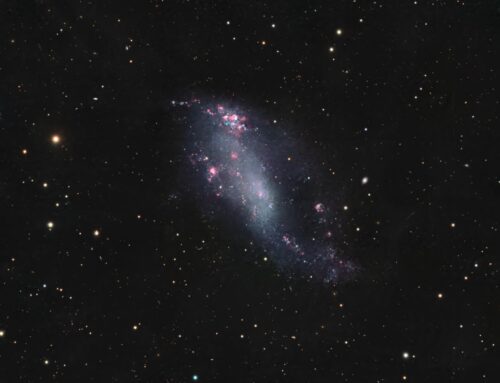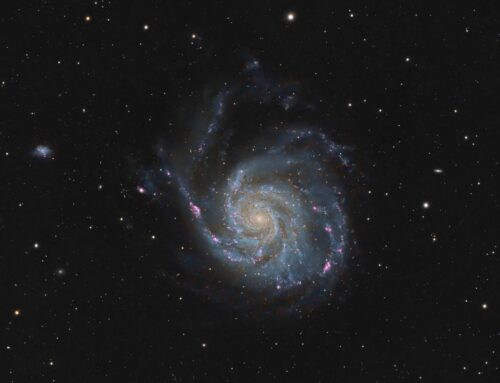Galaxy NGC2683
Click image for full size version
April 28, 2014
I shot this galaxy at low power in March 2014, and then again over the last few nights at a higher resolution, around 1 arc sec/pixel. I’ve been trying to follow “the road less traveled” when it comes to choosing objects. Yes, I am shooting big bright objects too, but I am trying to focus on capturing objects that are less often photographed. The constellation Lynx is well-placed for early evening observing or astrophotography at this time of year. However, it is faint and indistinct visually, and I’ve pretty much ignored it up until now. While flipping through my star atlas, I saw that although it contains many galaxies within its borders, none would be considered real “showpiece” objects. The most impressive galaxy there is NGC2638. It is a spiral galaxy (or maybe a barred spiral – there is ongoing debate about this) that lies about 16 million light years away and is nearly edge on to our line of sight. The galaxy shows a large population of old, yellowish stars and many dust lanes nearer the core, with the bluish tinge of star clusters in the extended arms. According to a write-up at the NASA APOD website, this galaxy is similar to our own Milky Way galaxy. There are many other faint galaxies in this image.
Tekkies:
SBIG STL-11000M camera, Baader LRGB filters, 10″ f/3.6 ASA astrograph (f/6.8 for high resolution luminance layer), Paramount MX. Guided with STL-11000’s internal guider for low resolution LRGB and with remote guide head and SV-80 for high-resolution luminance. Acquistion, guiding, calibration, integration all done using Maxim-DL. Image registration and all other processing in PixInsight. Shot from my SkyShed in Guelph, Ontario. Waxing crescent moon for low resolution images; no moon for high resolution luminance. Average to very good transparency and fair seeing throughout.
Low resolution layer (LRGB): 18x5m L, and 12x15m R, 8x5m G and 9x5m B unbinned frames =3hr55m).
High resolution layer (L only): 14x15m L un binned = 3hr30mTotal integration time = 7 hr 25m
Low resolution LRGB (March 2014): The R, G and B files produced in MaximDL were each background-corrected with DynamicBackgroundExtraction, registered and combined into an RGB image in in PixInsight. The RGB was processed with colour calibration, deconvolution, histogram stretch, HDR Multiscale transform, TGV noise reduction and saturation adjustment. The luminance was processed with Dynamic Background Extraction, deconvolution, histogram stretch HDR wavelets, TGV noise and Local Histogram Equalization. LinearFit and Lab channel Combination were used to match the luminance of the RGB to the L. The L and RGB images were then registered and the L applied to the RGB using LRGBCombine in PixInsight. Contrast, colour balance and colour saturation of the galaxy were adjusted using curves.
High resolution Luminance (April 2014): The luminance master file generated in MaximDL was background corrected with DBE. Dynamic PSF was used to create a PSF to use with Deconvolution. The image was then stretched and ACDNR applied to remove fine noise. After a further stretch, HDR Multiscale Transform was applied to the galaxy core (6 and 4 layers), followed by Local Histogram Equalization to restore contrast.
Combining High Resolution Luminance with Low Resolution LRGB: The colour image was aligned to the high resolution luminance and cropped. The L channel was extracted from the colour image, matched to the high resolution L with LinearFit, and combined back into the colour image using Channel Combine in the Lab colour space. Then LRGB Combine was used to apply the high resolution luminance to the colour image, producing a high-resolution colour image. Convolution was used to reduce core flares in the centre of the very brightest stars, and large scale noise was reduced in the background using ACDNR. Image scale is 1.1 arc sec/pixel.







Hi Ron, so many beautiful images throughout your galleries. I like the way that you have gone off the beaten path here with NGC 2683 in Lynx. Many deep-sky officianados overlook the non-descript constellations (easily done). I managed an image of this galaxy the other night ( a low quality night but useable) using a level entry DSLR (Nikon D3100) and a Tokina 400mm lens. i’m working on a longish project to acquire some basic widefield images that are close to what is seen in good binoculars & small telescopes. 5 minute exposures at ISO 3200 do the job. Nothing like the standard you obtain here, which are very inspirational by the way, but meet the purpose I am aiming for. Being at 40 degrees south NGC 2683 only culminates at 12.5 degrees. Just enough to get above the worst of the horizon crud on an average night. I am intrigued by the orangey dust area on the nearest edge of the galaxy. Cheers, Ian.